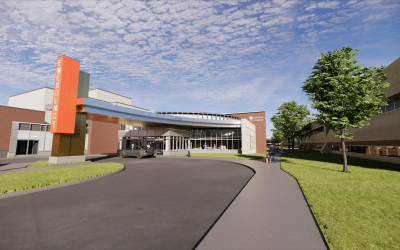When paired with smart hospital beds, MEDI+SIGN can help reduce patient falls using Patent-Pending ANTI-FALL™ technology.
Patent-pending algorithms use the information in the patient’s electronic health record to detect the patient’s fall risk and other factors, such as ventilation orders, and determine if the smart bed is in its safest position. The ANTI-FALL™ solution streamlines work processes and communicates updated and accurate alerts and information on the status of critical tasks relating to the care of individual patients and their safety.
Patient Whiteboard Room Display
The digital patient room display with ANTI-FALL™ alerts will involve the patient and family in their own care by indicating fall risk status and any unsafe conditions, including bed alarm status, bed rail position, bed height and brake status. If the patient and their family members know about a safety conflict, they have the opportunity to ask the nurse for help and to understand what the conflicts mean and how they can avoid them.
Patient Room Door Display
ANTI-FALL™ alerts are very useful outside each patient room. Any staff member can walk past a room and see if the bed alarm needs to be turned on in that room, or if a family member lowered one of the bed rails, bringing coordination of care to the next level. If the bed alarm is ringing in a patient room, an animated alert displays outside the room, making it obvious that the bed alarm is sounding in that room.
Nurse Station Display
With ANTI-FALL™ technology at the nurses’ station, staff can determine if the patient is in bed or not and if the bed rails are in their safest position according to their assessed fall risk, as well as the bed height, bed alarm and proper bed angle settings. With all patient rooms available at a glance, bed-related safety conflicts have never before been easier to identify.

An Assessment of Falls in Patients’ Rooms and Methods of Prevention
%
An Assessment of Falls in Patients’ Rooms and Methods of Prevention
22nd National Forum on Quality Improvement in Health Care Study for Saddleback Memorial Medical Center, Laguna Hills, CA
Want to learn more?
Contact us to learn more about integrating MEDI+SIGN into your health network. Contact UsFrom the Blog
MEDI+SIGN Digital Whiteboards Streamline Patient Care in Spencer Hospital’s New Emergency Department
Smithsburg, MD, June 25, 2025 — Spencer Hospital, located in Spencer, Iowa, is an accredited and award-winning hospital that serves quality care to the people of northwestern Iowa and southern Minnesota. The National Rural Health Association has named Spencer Hospital...
UNC Health Wayne Includes MEDI+SIGN Digital Whiteboards in Their Mission to Enhance Patient Care
Smithsburg, MD, January 9, 2025 — UNC Health Wayne, a leading healthcare institution committed to delivering exceptional patient care and innovative medical services, outfits its award-winning facility with MEDI+SIGN technology. Read the actual press release on PR...
UNC Health Blue Ridge Advances Innovation with MEDI+SIGN Digital Whiteboards
Smithsburg, MD, March 21, 2024 — UNC Health Blue Ridge outfits its new intensive care units with some of the best technology available, including the implementation of MEDI+SIGN® Digital Whiteboards and MEDI+SIGN Digital Door Displays, keeping with its commitment to...




